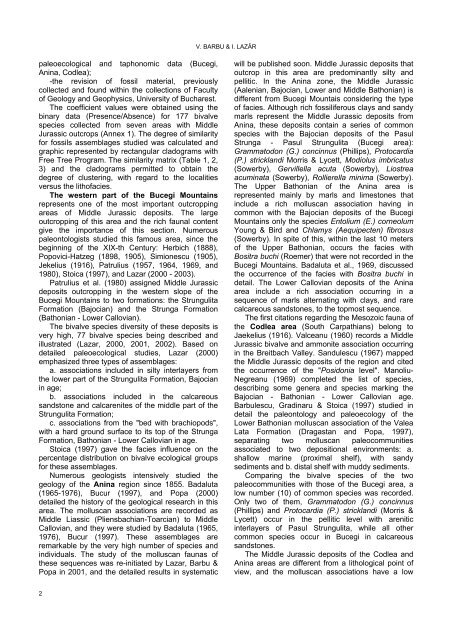statistical analysis of middle jurassic bivalve assemblages from
statistical analysis of middle jurassic bivalve assemblages from
statistical analysis of middle jurassic bivalve assemblages from
Create successful ePaper yourself
Turn your PDF publications into a flip-book with our unique Google optimized e-Paper software.
V. BARBU & I. LAZĂR<br />
paleoecological and taphonomic data (Bucegi,<br />
Anina, Codlea);<br />
-the revision <strong>of</strong> fossil material, previously<br />
collected and found within the collections <strong>of</strong> Faculty<br />
<strong>of</strong> Geology and Geophysics, University <strong>of</strong> Bucharest.<br />
The coefficient values were obtained using the<br />
binary data (Presence/Absence) for 177 <strong>bivalve</strong><br />
species collected <strong>from</strong> seven areas with Middle<br />
Jurassic outcrops (Annex 1). The degree <strong>of</strong> similarity<br />
for fossils <strong>assemblages</strong> studied was calculated and<br />
graphic represented by rectangular cladograms with<br />
Free Tree Program. The similarity matrix (Table 1, 2,<br />
3) and the cladograms permitted to obtain the<br />
degree <strong>of</strong> clustering, with regard to the localities<br />
versus the lith<strong>of</strong>acies.<br />
The western part <strong>of</strong> the Bucegi Mountains<br />
represents one <strong>of</strong> the most important outcropping<br />
areas <strong>of</strong> Middle Jurassic deposits. The large<br />
outcropping <strong>of</strong> this area and the rich faunal content<br />
give the importance <strong>of</strong> this section. Numerous<br />
paleontologists studied this famous area, since the<br />
beginning <strong>of</strong> the XIX-th Century: Herbich (1888),<br />
Popovici-Hatzeg (1898, 1905), Simionescu (1905),<br />
Jekelius (1916), Patrulius (1957, 1964, 1969, and<br />
1980), Stoica (1997), and Lazar (2000 - 2003).<br />
Patrulius et al. (1980) assigned Middle Jurassic<br />
deposits outcropping in the western slope <strong>of</strong> the<br />
Bucegi Mountains to two formations: the Strungulita<br />
Formation (Bajocian) and the Strunga Formation<br />
(Bathonian - Lower Callovian).<br />
The <strong>bivalve</strong> species diversity <strong>of</strong> these deposits is<br />
very high, 77 <strong>bivalve</strong> species being described and<br />
illustrated (Lazar, 2000, 2001, 2002). Based on<br />
detailed paleoecological studies, Lazar (2000)<br />
emphasized three types <strong>of</strong> <strong>assemblages</strong>:<br />
a. associations included in silty interlayers <strong>from</strong><br />
the lower part <strong>of</strong> the Strungulita Formation, Bajocian<br />
in age;<br />
b. associations included in the calcareous<br />
sandstone and calcarenites <strong>of</strong> the <strong>middle</strong> part <strong>of</strong> the<br />
Strungulita Formation;<br />
c. associations <strong>from</strong> the "bed with brachiopods",<br />
with a hard ground surface to its top <strong>of</strong> the Strunga<br />
Formation, Bathonian - Lower Callovian in age.<br />
Stoica (1997) gave the facies influence on the<br />
percentage distribution on <strong>bivalve</strong> ecological groups<br />
for these <strong>assemblages</strong>.<br />
Numerous geologists intensively studied the<br />
geology <strong>of</strong> the Anina region since 1855. Badaluta<br />
(1965-1976), Bucur (1997), and Popa (2000)<br />
detailed the history <strong>of</strong> the geological research in this<br />
area. The molluscan associations are recorded as<br />
Middle Liassic (Pliensbachian-Toarcian) to Middle<br />
Callovian, and they were studied by Badaluta (1965,<br />
1976), Bucur (1997). These <strong>assemblages</strong> are<br />
remarkable by the very high number <strong>of</strong> species and<br />
individuals. The study <strong>of</strong> the molluscan faunas <strong>of</strong><br />
these sequences was re-initiated by Lazar, Barbu &<br />
Popa in 2001, and the detailed results in systematic<br />
will be published soon. Middle Jurassic deposits that<br />
outcrop in this area are predominantly silty and<br />
pellitic. In the Anina zone, the Middle Jurassic<br />
(Aalenian, Bajocian, Lower and Middle Bathonian) is<br />
different <strong>from</strong> Bucegi Mountais considering the type<br />
<strong>of</strong> facies. Although rich fossiliferous clays and sandy<br />
marls represent the Middle Jurassic deposits <strong>from</strong><br />
Anina, these deposits contain a series <strong>of</strong> common<br />
species with the Bajocian deposits <strong>of</strong> the Pasul<br />
Strunga - Pasul Strungulita (Bucegi area):<br />
Grammatodon (G.) concinnus (Phillips), Protocardia<br />
(P.) stricklandi Morris & Lycett, Modiolus imbricatus<br />
(Sowerby), Gervillella acuta (Sowerby), Liostrea<br />
acuminata (Sowerby), Rollierella minima (Sowerby).<br />
The Upper Bathonian <strong>of</strong> the Anina area is<br />
represented mainly by marls and limestones that<br />
include a rich molluscan association having in<br />
common with the Bajocian deposits <strong>of</strong> the Bucegi<br />
Mountains only the species Entolium (E.) corneolum<br />
Young & Bird and Chlamys (Aequipecten) fibrosus<br />
(Sowerby). In spite <strong>of</strong> this, within the last 10 meters<br />
<strong>of</strong> the Upper Bathonian, occurs the facies with<br />
Bositra buchi (Roemer) that were not recorded in the<br />
Bucegi Mountains. Badaluta et al., 1969, discussed<br />
the occurrence <strong>of</strong> the facies with Bositra buchi in<br />
detail. The Lower Callovian deposits <strong>of</strong> the Anina<br />
area include a rich association occurring in a<br />
sequence <strong>of</strong> marls alternating with clays, and rare<br />
calcareous sandstones, to the topmost sequence.<br />
The first citations regarding the Mesozoic fauna <strong>of</strong><br />
the Codlea area (South Carpathians) belong to<br />
Jaekelius (1916). Valceanu (1960) records a Middle<br />
Jurassic <strong>bivalve</strong> and ammonite association occurring<br />
in the Breitbach Valley. Sandulescu (1967) mapped<br />
the Middle Jurassic deposits <strong>of</strong> the region and cited<br />
the occurrence <strong>of</strong> the "Posidonia level". Manoliu-<br />
Negreanu (1969) completed the list <strong>of</strong> species,<br />
describing some genera and species marking the<br />
Bajocian - Bathonian - Lower Callovian age.<br />
Barbulescu, Gradinaru & Stoica (1997) studied in<br />
detail the paleontology and paleoecology <strong>of</strong> the<br />
Lower Bathonian molluscan association <strong>of</strong> the Valea<br />
Lata Formation (Dragastan and Popa, 1997),<br />
separating two molluscan paleocommunities<br />
associated to two depositional environments: a.<br />
shallow marine (proximal shelf), with sandy<br />
sediments and b. distal shelf with muddy sediments.<br />
Comparing the <strong>bivalve</strong> species <strong>of</strong> the two<br />
paleocommunities with those <strong>of</strong> the Bucegi area, a<br />
low number (10) <strong>of</strong> common species was recorded.<br />
Only two <strong>of</strong> them, Grammatodon (G.) concinnus<br />
(Phillips) and Protocardia (P.) stricklandi (Morris &<br />
Lycett) occur in the pellitic level with arenitic<br />
interlayers <strong>of</strong> Pasul Strungulita, while all other<br />
common species occur in Bucegi in calcareous<br />
sandstones.<br />
The Middle Jurassic deposits <strong>of</strong> the Codlea and<br />
Anina areas are different <strong>from</strong> a lithological point <strong>of</strong><br />
view, and the molluscan associations have a low<br />
2
















